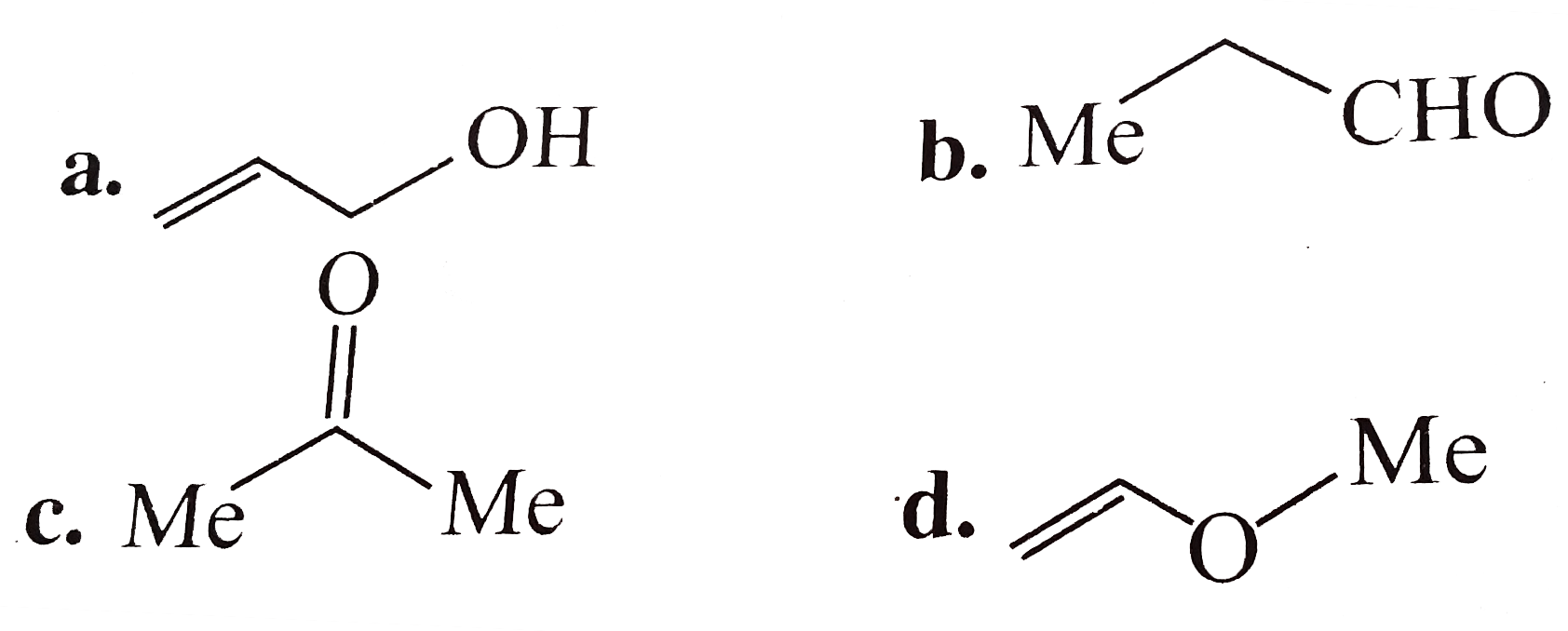An organic compound (X) with molecular formula C3H6O is not readily oxidised. On reduction it gives C3H8O (Y) which reacts with HBr to give alkyl bromide (Z) which is converted to Grignard reagent. Grignard reagent reacts with (X) to give 2 , 3-dimethylbutan-2-ol. (X), (Y) and (Z) repectively are.
CH3COCH3,CH3CH2CH2OH,CH3CH(Br)CH3
CH3CH2CHO,CH3CH=CH2,CH3CH(Br)CH3
CH3COCH3,CH3CH(OH)CH3,CH3CH(Br)CH3
CH3CH2CHO,CH3CH2CH2OH,CH3CH2CH2Br
The correct Answer is:C
To solve the problem step by step, we need to identify the compounds (X), (Y), and (Z) based on the information provided.
Step 1: Identify Compound (X)
The molecular formula of compound (X) is C3H6O. The problem states that (X) is not readily oxidized, which suggests that it is a ketone rather than an aldehyde, as aldehydes are easily oxidized. The simplest ketone with the formula C3H6O is acetone (CH3COCH3).
Conclusion:
(X) = Acetone (CH3COCH3)
Step 2: Identify Compound (Y)
The problem states that on reduction, (X) gives (Y), which has the formula C3H8O. When acetone is reduced, it forms a secondary alcohol. The reduction of acetone leads to the formation of 2-propanol (isopropanol).
Conclusion:
(Y) = 2-Propanol (CH3CHOHCH3)
Step 3: Identify Compound (Z)
Next, we know that (Y) reacts with HBr to form an alkyl bromide (Z). The reaction of 2-propanol with HBr will lead to the formation of 2-bromopropane.
Conclusion:
(Z) = 2-Bromopropane (CH3CHBrCH3)
Step 4: Grignard Reagent Formation
The compound (Z) is then converted to a Grignard reagent. The Grignard reagent formed from 2-bromopropane will be isopropyl magnesium bromide (CH3CH(MgBr)CH3).
Step 5: Reaction of Grignard Reagent with (X)
The Grignard reagent reacts with (X) (acetone) to give 2,3-dimethylbutan-2-ol. The reaction involves nucleophilic addition of the Grignard reagent to the carbonyl carbon of acetone, followed by hydrolysis.
Final Conclusion:
- (X) = Acetone (CH3COCH3)
- (Y) = 2-Propanol (CH3CHOHCH3)
- (Z) = 2-Bromopropane (CH3CHBrCH3)
Summary
- (X) = Acetone
- (Y) = 2-Propanol
- (Z) = 2-Bromopropane
The molecular formula of compound (X) is C3H6O. The problem states that (X) is not readily oxidized, which suggests that it is a ketone rather than an aldehyde, as aldehydes are easily oxidized. The simplest ketone with the formula C3H6O is acetone (CH3COCH3).
(X) = Acetone (CH3COCH3)
The problem states that on reduction, (X) gives (Y), which has the formula C3H8O. When acetone is reduced, it forms a secondary alcohol. The reduction of acetone leads to the formation of 2-propanol (isopropanol).
(Y) = 2-Propanol (CH3CHOHCH3)
Next, we know that (Y) reacts with HBr to form an alkyl bromide (Z). The reaction of 2-propanol with HBr will lead to the formation of 2-bromopropane.
(Z) = 2-Bromopropane (CH3CHBrCH3)
The compound (Z) is then converted to a Grignard reagent. The Grignard reagent formed from 2-bromopropane will be isopropyl magnesium bromide (CH3CH(MgBr)CH3).
The Grignard reagent reacts with (X) (acetone) to give 2,3-dimethylbutan-2-ol. The reaction involves nucleophilic addition of the Grignard reagent to the carbonyl carbon of acetone, followed by hydrolysis.
- (X) = Acetone (CH3COCH3)
- (Y) = 2-Propanol (CH3CHOHCH3)
- (Z) = 2-Bromopropane (CH3CHBrCH3)
- (X) = Acetone
- (Y) = 2-Propanol
- (Z) = 2-Bromopropane
Topper's Solved these Questions
- BOOK - NCERT FINGERTPS ENGLISHCHAPTER - ALDEHYDES, KETONES AND CARBOXYLIC ACIDSEXERCISE - MCQs( NOMENCLATURE AND STRUCTURE OF CARBOXYL GROUP )2videos
ALDEHYDES, KETONES AND CARBOXYLIC ACIDS
- BOOK - NCERT FINGERTPS ENGLISHCHAPTER - ALDEHYDES, KETONES AND CARBOXYLIC ACIDSEXERCISE - MCQs( METHODS OF PREPARATION OF CARBOXYLIC ACIDS )7videos
ALDEHYDES, KETONES AND CARBOXYLIC ACIDS
- BOOK - NCERT FINGERTPS ENGLISHCHAPTER - ALDEHYDES, KETONES AND CARBOXYLIC ACIDSEXERCISE - MCQs(PHYSICAL PROPERTIES )2videos
ALDEHYDES, KETONES AND CARBOXYLIC ACIDS
- BOOK - NCERT FINGERTPS ENGLISHCHAPTER - ALCOHOLS,PHENOLS AND ETHERSEXERCISE - Assertion And Reason14videos
ALCOHOLS,PHENOLS AND ETHERS
- BOOK - NCERT FINGERTPS ENGLISHCHAPTER - AMINES EXERCISE - ASSERTION & REASON CORNER14videos
AMINES
Similar Questions
A compound (X) with the molecular formula C3H8O can be oxidized to another (Y) whose molecular formula is C3H6O2
The compound (X) may beView SolutionAn optically active compound 'X' has molecular formula C4H8O3. It evolves CO2 with NaHCO3. 'X' reacts with LiAIH4 to give an achiral compound 'X' is:
View Solution
Knowledge Check
- Question 1 - Select One
A compound X with the molecular formula , C3H8O can be oxidised to another compound Y whose molecular formula is C3H6O2. The compound X may be
Aprimary alcoholBsecondary alcoholCaldehydeDketone - Question 2 - Select One
A compound X with moleuclar formula C3H8O can be oxidized to a compoud Y with the molecular formula C3H6O2. X is most likely to be a:
ACH3CH2OCH3BCH3CH2CHOCCH3CH2CH2OHDCH3CHOHCH3 - Question 3 - Select One
An organic compound of molecular formula C3H6O did not give a silver mirror with with Tollens' reagent but give an oxime with hydroxylamine. It may be
ACH2=CH−CH2−OHBCH3COCH3CCH3CH2CHODCH2=CH−OCH3
An organic compound having molecular formula C3H6O does not react with 2,4-dintrophenol hydrazine and does not react Na metal. The compound is expected to be:
View SolutionAn organic compound of molecular formula C3H6O did not give a silver mirror with Tollens reagent but gave a positive Brady's test and positive iodoform test. It may be:
 View Solution
View SolutionA compound Z with molecular formula C3H9N reacts with C6H5SO2Cl to give a solid, insoluble in alkali. Identify Z.
View SolutionAn organic compound having molecular formula C3H6O does not react with 2, 4-dinitrophenyl hydrazine and does not react with Na metal. The compound is expected to be :
View SolutionAn optically active compound 'X' has molecular formula C4H8O3. If evolves CO2 withNaHCO3. 'X' reacts with LiAlH4 to give an achiral compound 'X' is -
View Solution

